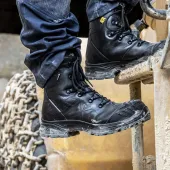HSE annual workplace fatality figures

Preliminary figures reveal 144 British workers were fatally injured in 2017/18, including four in mining and quarrying
THE Health and Safety Executive (HSE) recently released its provisional annual figures for work-related fatal injuries for 2017/18, which revealed that 144 workers were fatally injured between April 2017 and March 2018 (a rate of 0.45 per 100,000 workers).
Although this represents an increase of nine fatalities from 2016/17, there has been a long-term reduction in the number of fatalities since 1981 and the number has remained broadly level in recent years.
HSE chair Martin Temple said: ‘Despite the fact that Britain’s health and safety record is the envy of much of the world, the increase in the number of workers fatally injured is clearly a source of concern…
‘The figures serve as a reminder of why health and safety is so important and that we must not become complacent as we continue on our mission to prevent all forms of injury, death and ill health at work.’
The new figures show how fatal injuries are spread across different industrial sectors:
- 38 fatal injuries to construction workers were recorded, accounting for the largest share of any industry. The annual average rate over the last five years in construction is around four times as high as the all-industry rate.
- 29 fatal injuries to agricultural workers were recorded. This sector continues to account for a large share of the annual fatality count. It has the highest rate of fatal injury of all the main industry sectors, around 18 times as high as the all-industry rate.
- 12 fatal injuries to waste and recycling workers were recorded. Despite being a relatively small sector in terms of employment, the annual average fatal injury rate over the last five years is around 16 times as high as the all-industry rate.
- 15 fatal injuries were recorded in both the manufacturing and the transport and storage sectors. Both industries have an annual average rate of fatal injury around 1.5–2 times the rate across all industries over the last five years.
- Four fatal injuries were recorded in the mining and quarrying sector, which is around five times as high as the average rate across all industries and broadly similar to that seen in construction.
The three most common causes of fatal injuries continue to be due to workers falling from height (35), being struck by a moving vehicle (26) and being struck by a moving object (23), accounting for nearly 60% of fatal injuries in 2017/18.
The new figures also highlight the risks to older workers; 40% of fatal injuries in 2017/18 were to workers aged 60 or over, even though such workers made up only around 10% of the workforce.
The HSE says a fuller assessment of work-related ill health and injuries, drawing on its full range of data sources, will be provided as part of its annual Health and Safety Statistics release on 31 October 2018.









